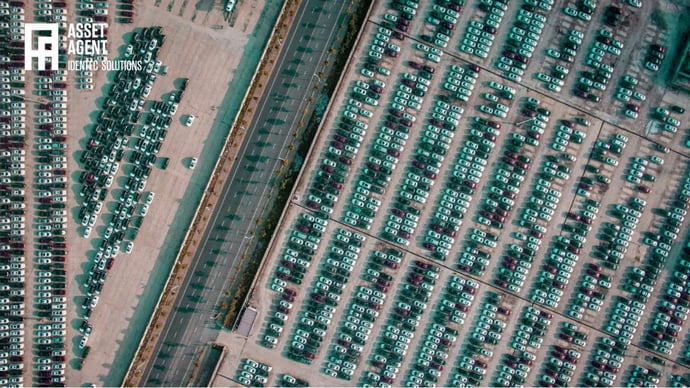Automation of Manufacturing process or How to increase tire output production plants
| Written by Christian Aadal

No video selected
Select a video type in the sidebar.
What challenges do tire manufacturers have?
The shop floor logistics necessary are complex and prone to human errors. Getting the right material to the right tire-building machine at the right time can be a hassle. Manual bar code scans are still common practice, yet outdated, costly and not well suited for a First Expired First Out (FEFO) based production.
It is common practice in tire manufacturing to load raw materials onto material carriers (or bobbins) at the so-called cutting machines, to store these carriers in storage locations and to transport the right carriers to the staging area of a tire building machine where the right carriers need to get inserted into the matching slots of a tire building machine.
In a large-scale production environment with multiple storage areas on several floor levels, thousands of material carriers and hundreds of cutting and tire-building machines, production logistics becomes a challenge aggravated by keeping control of the FEFO principle.
An unintended violation of the FEFO principle can lead to perished raw materials. Long search times for specific material carriers reduce labour productivity and increase the risk of perished goods. One missing carrier at the staging area – or just a forgotten scan of a carrier – impedes the start of the production order, reducing machine utilization and labour productivity. And finally, the wrong material inserted into the tire-building machine results in a drop in profitability.
Automotive industry: Learn how to optimise locating vehicles in your after-production car park
But first, let's delve into a short discussion about the basics of automated manufacturing...
Manufacturing: A Cornerstone of Economic Progress
Since the dawn of the Industrial Revolution, manufacturing has stood as a cornerstone of economic progress. It's an industry that has continually evolved, integrating breakthroughs in science, engineering, and technology to enhance productivity and innovation. In recent decades, one technological advancement has risen to prominence, fundamentally altering the manufacturing landscape: automation.
A significant majority, 86% of industrial companies globally, have embraced automation to boost productivity. Automation, which involves using technology, machinery, and processes with minimal human intervention, delivers advantages like increased efficiency, fewer errors, and cost savings. This high adoption rate highlights the widespread recognition of automation's benefits within the industrial sector, including streamlined operations, optimized production processes, and improved business performance. The statistic indicates a growing trend toward automation as a strategic tool for maintaining competitiveness in today's rapidly evolving industrial landscape (1).
In simple terms, automation in manufacturing refers to the use of control systems, such as computers or robots, and technology like AI and machine learning, to handle different processes and machinery in an industry that are replacing human intervention. Automation enables more efficient, consistent, and high-quality production with reduced human error. It's not just a single technology but a blend of sophisticated software, robotics, artificial intelligence, and precise machinery, all working in tandem to revolutionize how we produce goods.
Before Automation: The Era of Manual Manufacturing
Before the era of automation, manufacturing was predominantly manual. Skilled artisans and workers were the primary means of production, with processes heavily reliant on human labour and traditional tools. This era, while skilled, was marked by slower production rates, inconsistent quality, and limited scalability. The capacity for mass production was minimal, and the manufacturing industry was ripe for a transformative change.
The genesis of automation in manufacturing can be traced back to the early 20th century when Henry Ford introduced assembly lines in automobile production. This marked the beginning of what would become a major shift in manufacturing processes. Over the years, automation evolved, initially through simple mechanization and later through the introduction of computer technology and robotics. This shift not only increased production rates exponentially but also opened new realms of precision, complexity, and efficiency in manufacturing.
However, with current technological capabilities, up to 90% of manufacturing tasks can be automated. This statistic reveals a significant potential for automation to revolutionize the manufacturing industry, enhancing efficiency, productivity, and cost savings. By automating these tasks, companies can streamline processes, reduce errors, and optimize resource utilization. However, actual implementation depends on factors such as task complexity, technology adoption costs, and workforce skills (2).
What is the Automation of a Manufacturing Process?
Automation of manufacturing processes is the application of various technologies to control and monitor production processes, reducing the need for human intervention. This encompasses everything from basic control systems to advanced robotics and artificial intelligence.
Types of Automation
- Programmable Automation: Used for batch production, this type involves the use of programmable devices (like CNC machines) that can be reprogrammed for different tasks.
- Fixed Automation: Also known as hard automation, this is characterized by specialized equipment designed to produce one type of product. It's highly efficient but lacks flexibility.
- Flexible Automation: A hybrid of programmable and fixed automation, it offers some flexibility to adapt to different production processes without significant reconfiguration.
Key Components
The backbone of manufacturing automation lies in its components:
- Robotics: Robotics are pivotal in automation and are used for tasks ranging from assembly to painting.
- Artificial Intelligence and Machine Learning: These technologies enable machines to make decisions and improve processes based on data analysis.
- Sensors and IoT Devices: These components collect and transmit data, facilitating real-time monitoring and adjustments in the manufacturing process.
How can tire manufacturers improve their KPIs?
In order to reduce production costs, tire manufacturers must increase machine utilization, reduce scrap of raw materials, eliminate production errors of the final product and increase labour productivity.
Any IIoT-based solution must focus on the whole process, from loading raw material onto a material carrier (or bobbin), managing the storage and staging areas, as well as the insertion of carriers into the tire-building machine.
Asset Agent is an RTLS tracking solution that solves all these issues: Every carrier gets outfitted with a battery-powered device—a so-called transponder—which enables the Asset Agent application software to identify, locate, and communicate with every single material carrier at any given location in the production plant. The solution scales up to thousands of transponders in one plant and works outdoors if required.
The Asset Agent server application offers standard interfaces to ERP systems (e.g., SAP Extended Warehouse Management—EWM), as well as other production and material flow management systems, for seamless integration into existing IT infrastructure.
Further reading: RFID for asset tracking

How does Asset Agent work in detail?
When the raw material gets loaded onto a carrier at the cutting machine, Asset Agent checks via a patented wireless location technology if the carrier/ material association is correct and provides immediate visual feedback to the worker via a red-yellow-green LED indication integrated into the transponder. The carrier can be moved to any storage location, allowing chaotic storage because the Asset Agent always knows its position with unmatched precision, also in a metal-obstructed production environment.
The integrated LED indication serves as a pick-by-light system when a worker must find a specific carrier in the storage area – finding instead of searching is the design principle of Asset Agent. The carrier gets dropped onto the staging area, and the Asset Agent communicates its location automatically to the ERP system to complete the transport order and assigns material to individual building machines. Finally, while the carrier is pushed into the tire building machine, Asset Agent: Green for everything is ok, yellow for the right material yet the wrong batch and hence a violation of the FEFO principle, and red for the wrong material.
How Does Asset Agent Improve Your KEY Performance Indicators?
The entire tire-building process becomes immune to human errors without any user interaction, therefore eliminating manual barcode scans. Every communication with the user is based on a globally established communication standard – a simple three-colour traffic light system – that doesn’t require any training.
Carrier search times are reduced, scrap due to perished raw material is abolished, and machine utilization and labour productivity go up. All in all, this leads to an increase in tire output volume of up to 3% without investment into additional tire-building machines or more personnel.
14 things to consider when implementing a Real Time Location System
Asset Agent is an industrial-grade solution with a compelling ROI
Used in production for many years in tire manufacturing plants across the globe, Asset Agent can be installed in any existing infrastructure, with the transponders providing an IP 65 rating. With its standard Power over Ethernet (PoE) and out-of-the-box interfaces to all major ERP systems, seamless integration into existing IT infrastructure is guaranteed. With a battery lifetime of up to 8 years, depending on the use case, only minimal hardware maintenance is required (see also: Why you need RFID for RTLS).
Asset Agent is designed for automated health checks of all infrastructure components, including the transponders, and integrates with network, server and log monitoring software such as Nagios, PRTG Network Monitor, Solar Winds and others. Even the battery exchange could be managed proactively by Asset Agent in connection with the plant’s PMS system to minimize the effort for plant maintenance personnel.
The initial investment costs are proven to have a compelling payback period of less than one year.
FAQs
How does automation help overcome challenges in tire manufacturing?
Automation, particularly with systems like Asset Agent, addresses the complex shop floor logistics and human error issues in tire manufacturing. By automating the process of tracking and managing raw materials, these systems significantly reduce errors associated with manual barcode scans and ensure adherence to the First Expired First Out (FEFO) principle. With precise tracking and automated validation, the risk of using perished materials is minimized, and the efficiency of material handling is maximized. This leads to increased machine utilization, reduced scrap, and improved labour productivity, directly enhancing key performance indicators (KPIs) for tire manufacturers.
What are the key components of manufacturing automation, and how do they apply to tire production?
The key components of manufacturing automation include robotics, artificial intelligence, machine learning, and sensors/IoT devices. In tire production, these components can be integrated through systems like Asset Agent. Robotics can be used for tasks like material handling and assembly, while AI and machine learning algorithms can optimize production schedules and predictive maintenance. Sensors and IoT devices play a crucial role in tracking materials and equipment, ensuring that the right materials are delivered to the right machine at the right time, thus streamlining the entire production process.
What is the impact of implementing automation solutions like Asset Agent on ROI and production efficiency?
Implementing automation solutions such as Asset Agent in tire manufacturing can significantly improve return on investment (ROI) and production efficiency. These systems reduce the need for manual intervention, lower the risk of errors, and enhance overall process efficiency. The reduction in search times for specific material carriers, the elimination of scrap due to perished raw materials, and improved machine utilization directly translate to higher productivity. With systems like Asset Agent, tire manufacturers can expect an increase in tire output volume by up to 3% without additional investments in machinery or personnel. The initial investment in these automation systems typically has a payback period of less than one year, making it a cost-effective solution with a compelling ROI.
Takeaway
The integration of automation in manufacturing processes marks a significant leap towards efficiency, precision, and productivity. From the historical shift initiated by assembly lines to the advanced application of technologies like AI and IoT in systems like Asset Agent, automation has redefined manufacturing. It offers a solution to complex logistical challenges, minimizes human error, and enhances key performance indicators. As industries like tire manufacturing illustrate, the embrace of automation is not just a trend but a fundamental shift, ensuring sustainable growth, competitive advantage, and a strong return on investment in the ever-evolving landscape of manufacturing.
Delve deeper into one of our core topics: Real-time locating system and industry 4.0
Glossary
Power over Ethernet (PoE) is a technology that enables the delivery of electrical power and data over a single Ethernet cable. It eliminates the need for separate power supplies, simplifying installation and reducing costs for devices like IP cameras, wireless access points, and VoIP phones. PoE operates under IEEE standards such as 802.3af, 802.3at, and 802.3bt, offering varying power levels to support diverse device requirements.
Sources:
(1) https://www.mckinsey.com
(2) https://www.grandviewresearch.com
(3) Shepherd, T. (2020). Networking All-in-One For Dummies (8th ed.). Wiley.
Note: This article has been updated on the 13th of January 2025

Author
Mark Buzinkay, Head of Marketing
Mark Buzinkay holds a PhD in Virtual Anthropology, a Master in Business Administration (Telecommunications Mgmt), a Master of Science in Information Management and a Master of Arts in History, Sociology and Philosophy. Mark spent most of his professional career developing and creating business ideas - from a marketing, organisational and process point of view. He is fascinated by the digital transformation of industries, especially manufacturing and logistics. Mark writes mainly about Industry 4.0, maritime logistics, process and change management, innovations onshore and offshore, and the digital transformation in general.




